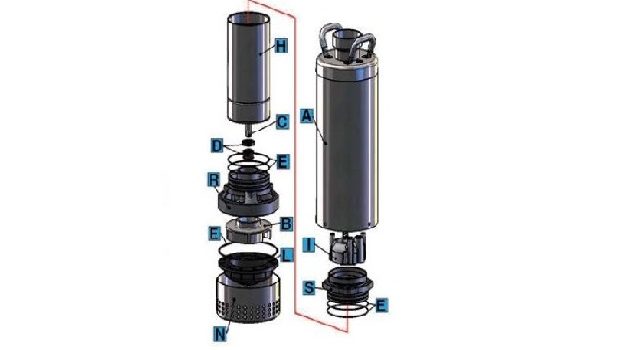A typical submersible pump works in a reasonably simple way. It starts by converting rotary energy into kinetic energy by using pressure energy pulled in from the pump. As the water goes through the pump, it goes through the intake and then pushed through the rotation of the impeller and into the diffuser. After this point, the water will then flow up to the surface where it can be used appropriately.
In this way, these pumps are considered a multistage centrifugal pump. Each operates in a vertical position to produce a large amount of pumping power. The hydraulic motor inside of the pump is often a closed cycle pump, though it may also be an open cycle in some instances. The differences between the two aren’t that important to consider because of how both work in very similar ways.
Without dwelling too much on the mechanical aspects, anyone interested in this pump should also keep a few other elements in mind. First, your pump must be always submerged to provide benefits. If it comes out of the water, it may end up overheating or experiencing other complications. Thankfully, these are usually quite minor and shouldn’t be too hard to avoid if you take the time to understand the full operational possibilities of this pump fully.
A typical submersible pump also has a multitude of different operational uses to keep in mind. For example, they can be used to drain fluids from a large field to keep their water levels reasonable. They can also be used to move sewage, manage pond filter operation, and can even be used in oil wells. And the types that we offer are often used to pump water for wells in homes or businesses. This diverse range of processes makes them a useful tool to keep in mind for your service.
Sequence of Operating Steps
What happens when you turn on the water at a faucet in a building whose water is supplied by a submersible well pump?
The following steps describe normal operating of a building well pump and water supply system.
- Turn on building water at a plumbing fixture: open a sink valve, tub valve, or flush a toilet.
- Water runs out of the supply faucet, into the fixture, down the drain
- Water pressure and flow are being supplied to the building from a water pressure tank.
If we didn’t use a pressure tank, because water is not very compressible, the second water was turned on, water pressure in the system would drop below the pump cut-on pressure, the pump would turn on, and probably bring water pressure up to the cut-off pressure quickly, causing short cycling and burning up pump controls or a pump motor.
- Pressure in the water pressure tank and in the building piping system drops down to the well pump cut-in pressure.
Typically this is 20 or 30 psi on a residential water system. On a submersible well pump system the cut-in pressure may be as much as 40 psi.
- The well pump pressure control switch senses the pressure drop, closes an internal electrical relay switch to turn on the submersible well pump.
OR
- A separate pump relay switch turns on the submersible well pump as follows:
the well pump pressure control switch senses the pressure drop, closes its internal electrical relay switch to in turn send power to a heavier-duty pump relay switch (usually mounted on a wall near the pressure tank and other water controls). The pump relay switch turns on the well pump.
In the submersible well pump photo above you can see extra pump relay switch boxes at the left of the red arrow. The arrow itself points to a submersible well pump that has been removed from the well and left in the utility space that houses a water pressure tank and control that are partly visible in the right side of the photo.
Running a high-amp well pump off a little pressure control switch will often burn up the switch contacts, or the amperage draw may exceed the rating of the pressure switch itself – that’s why the relay switch is used.
- The well pump motor runs, drawing water back into the building from the well by “sucking” water up from a shallow depth (a one-line jet pump can’t draw water from much below 25 feet)
- Water is forced into the building water pressure tank and simultaneously into the building piping and on to the plumbing fixtures.
- If the pump sends water into the building faster than water is flowing out of the open faucet or plumbing fixture,
the pump will “get ahead” of the water flow, successfully pressurizing the water tank, causing the pressure switch to turn off the pump (see step 10 below).
OR
- If the pump cannot send water into the building faster than water is flowing out of the open faucet or plumbing fixture, the well pump will run continuously
and water will flow out of the open faucet or plumbing fixture at a rate limited basically by the pump’s water delivery flow rate in gallons per minute.You’ll also find this condition if a building water supply pipe bursts.
We say “basically” because the well piping and building piping and faucets themselves offer some back-pressure against the pump’s flow rate. In this case, the well pump will continue to run until the building faucets or plumbing fixtures are turned off. At that point …
- The well pump pressure control switch senses that water pressure has increased to the cut-out point, opening its switch, and turning off electrical power to the well pump. The well pump has re-pressurized the building water tank and piping up to the cut-out or cut-off water pressure.
Cut-out pressures are typically set to 40 psi or 50 psi. If you set the cut-out pressure too high the pump may never reach it and will run continuously, or you may find frequent plumbing leaks, or even an unsafe condition, risking bursting a pipe or water pressure tank.
Many submersible well pumps are capable of pumping to high enough pressure to damage the plumbing system or burst a water tank. That’s why water pressure tanks need a pressure relief valve installed.
- The foot valve closes (at the bottom of the well piping) and/or a check valve located in the building on or close to the well pump closes, preventing water and pressure from flowing backwards down into the well, losing building water pressure, and possibly losing pump prime.
However, because the submersible pump is inside the well at the bottom of the well piping, loss of prime is not a problem directly – that is, the submersible pump, because it is under water, will have no trouble re-starting. But still a bad check valve or foot valve means you may lose building pressure between well pump cycles.
Advantages and disadvantages
Advantages:
- No need to prime – This benefit helps to make this pump one of the most accessible classes to operate and will ensure that you don’t spend too much time or money on them or their upgrades
- High efficiency – The low level of energy necessary for using this type of pump makes them very efficient and an excellent choice for those who don’t have a lot of money
- Selection option – You should be able to find a wide variety of submersible options for your pumps, which makes them an excellent choice for those who have many uses for these units
- Quiet operation – Most submersible units of this type are very quiet because they are under water and because cavitation or a spike in pump pressure is never an issue with this unit
Disadvantages:
- Seal corrosion – If the seal on your pump corrodes, water will seep into the motor and may cause severe damage that is costly to repair
- Some use limitation – Though these pumps have many great uses, there are a few situations in which they may not work, though they are great for water wells
- Overheating potential – If your well runs out of water or gets too low, your pump may end up overheating because the surrounding water controls its temperature
Sources:
www.brownwellpump.com
www.inspectapedia.com


